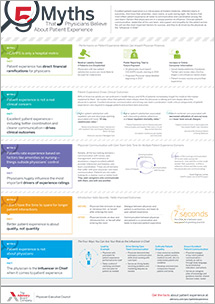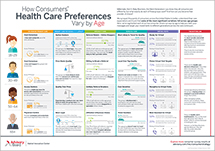Auto logout in seconds.
Continue LogoutEditor's note: This popular story from the Daily Briefing's archives was republished on July 23, 2019.
What doctors wear matters to patients, according to a study published in the journal BMJ Open, which found that patients prefer their doctors to wear formal attire and a white coat.
What your patients expect from their care—from millennials to the silent generation
Study details
For the study, researchers asked over 4,000 patients to view male and female physicians wearing seven different types of attire in both outpatient and inpatient clinical settings:
- Casual—the physician wore a collared, short-sleeve shirt with jeans and tennis shoes;
- Casual with a white coat—the physician wore a collared, short-sleeve shirt with jeans, tennis shoes, and a white coat;
- Scrubs—the physician wore a blue scrub top with matching pants and tennis shoes;
- Scrubs with a white coat—the physician wore a blue scrub top with matching pants, tennis shoes, and a white coat;
- Formal—the physician wore a light blue, long-sleeved buttoned-down dress shirt with navy suit pants. The men wore black leather shoes and a dark blue tie while the women wore one-inch heels;
- Formal with a white coat—the physician wore a light blue, long-sleeved buttoned-down dress shirt with navy suit pants and a white coat. The men wore black leather shoes and a dark blue tie while the women wore one-inch heels; and
- Business suit—the physician wore a navy blue business suit and pants with the same dress shirt, tie, and shoe combination worn in the formal option.
For each type of attire, patients were asked to rate the physician based on four characteristics:
- Approachable;
- Caring;
- Comfortable;
- Knowledgeable; and
- Trustworthy.
Findings
Just over half of the patients said they preferred the formal with a white coat option, according to the study. Patients over the age of 65 were most likely to prefer the formal with a white coat option, the researchers found. The second-highest rated option was scrubs with a white coat, followed by formal attire without a white coat.
The researchers found that, overall, patients did not prefer male physicians to dress differently than female physicians. The only difference the researchers noted was for male surgeons, with participants saying they preferred male surgeons to wear formal attire without a white coat, and expressing no preference on whether female surgeons wore white coats.
The researchers also found that the attire patients preferred varied by care setting. According to the study, 62% of patients said they either agreed or strongly agreed that doctors seeing patients in a hospital should wear a white coat, and 55% said doctors in an office setting should wear a white coat. Fewer patients, 44%, said emergency physicians should wear a white coat, according to the study.
Discussion
Christopher Petrilli, the lead author on the study and an assistant professor of hospital medicine at the University of Michigan, said it's apparent patients "care about attire and may expect to see their doctor in certain ways," which he said explains why white coats received higher ratings for "approachability," as patients "may see a white coat similar to a physician's 'uniform' and may similarly also expect formal attire in most settings." He added that, as the health care industry increasingly focuses on patient satisfaction, "physician attire may be an important, easily modifiable component of the patient care experience."
The study authors recommended that providers implement "nuanced policies addressing physician dress code to improve patient satisfaction," as those policies "appear important" (Bharanidharan, "The Grapevine," Medical Daily, 6/7; Science Daily, 6/6; Gooch, Becker's Hospital Review, 6/4).
What your patients expect from their care—from millennials to the silent generation
Millennials, Gen X, Baby Boomers, the Silent Generation—what exactly do each of these groups want from their health care?
We surveyed thousands of consumers across the United States to find out. Download this infographic to learn how to tailor your messages and target your investments to each generation.
Don't miss out on the latest Advisory Board insights
Create your free account to access 1 resource, including the latest research and webinars.
Want access without creating an account?
You have 1 free members-only resource remaining this month.
1 free members-only resources remaining
1 free members-only resources remaining
You've reached your limit of free insights
Become a member to access all of Advisory Board's resources, events, and experts
Never miss out on the latest innovative health care content tailored to you.
Benefits include:
You've reached your limit of free insights
Become a member to access all of Advisory Board's resources, events, and experts
Never miss out on the latest innovative health care content tailored to you.
Benefits include:
This content is available through your Curated Research partnership with Advisory Board. Click on ‘view this resource’ to read the full piece
Email ask@advisory.com to learn more
Click on ‘Become a Member’ to learn about the benefits of a Full-Access partnership with Advisory Board
Never miss out on the latest innovative health care content tailored to you.
Benefits Include:
This is for members only. Learn more.
Click on ‘Become a Member’ to learn about the benefits of a Full-Access partnership with Advisory Board
Never miss out on the latest innovative health care content tailored to you.


